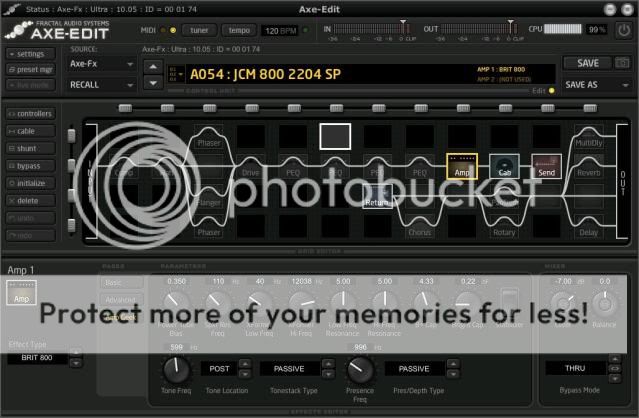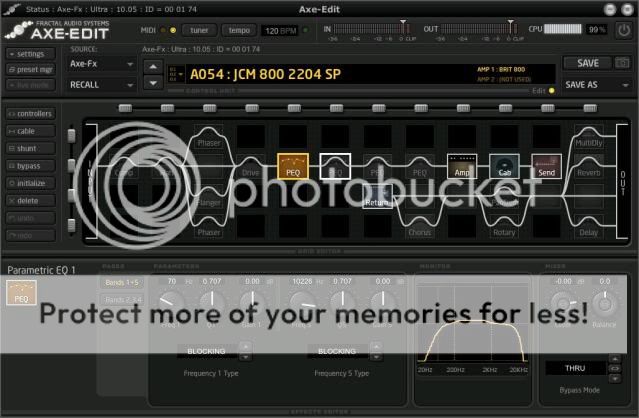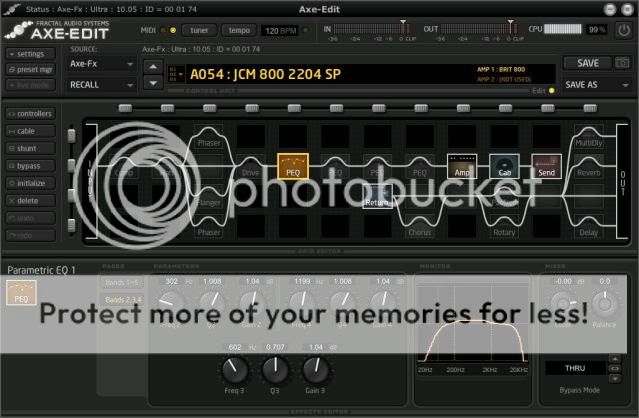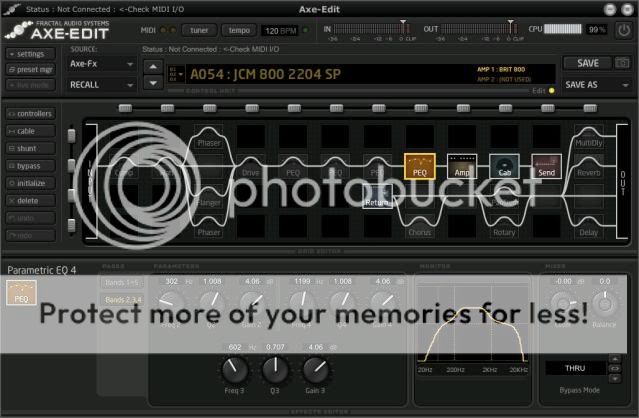I've been hinting at this for some time, but wanted to get it right. Really right, before I posted anything.
I think I've got it right now.
In short, for context, I've been a creature of habit and the Axe-FX doesn't really reward that. Sometimes you are too busy to take a breath and tear everything you have been doing down. Start from scratch. Rethink it. Rework it. And since it is the Axe-FX, reboot it.
So I tore it ALL down. Started fresh, clean palette. I wrote down all my goals and wants in a preset and built it. Every single block. Where, why, how, when.
So I'll share the full preset; but do a running commentary on what I did in each block. Why I did it. How I did it.
First a few disclaimers: this is just how I set up this box. I run FRFR. I am an amp/cab tone based guy; effects are used here and there, I like options, but I don't often go there and actually use them unless they are called for or needed. I base my presets on the notion that each preset is an amp/cab based signal chain based on that amp and that cab with a slew of possible effects to add in as needed.
This is my way. This is not the ONLY way. This is not the RIGHT way. It's just me showing my cards in the hope that doing so helps others see how I work, why I do what I do and how I do what I do. My goal is help others find their own path.
The clip is featuring my (new to me) 1995 PRS Custom 22, using the bridge pickup (High Order 8.3K Scatterwound A2 Alnico magnet) direct to the Axe-FX, recorded direct into Reaper through my Lexicon I-ONIX U22 audio interface. Analog outs on the Axe-FX. No post processing, no limiting, no EQ, no reverb. No nothing.
The amp settings: pretty standard stuff. I chose the JCM800 here, because so many use it and even if not, most are familiar with it that this will all make sense later in the post with the PEQ boosts and so forth.
The settings on this amp are quite flexible depending on what you want it to do. You can run this as a non-master volume amp or you can lower the Master Volume setting and crunch it up for more of a hotrod Marshall tone. I sort of split the difference with it as presented here. The master is up at about 5.55, which is far about the normal "Master Volume" amp (IMHO) of about 3.50 or so. The actual way I dial up this sort of amp is to work with the controls in the first window all at noon initially. I set the cabinet resonance (I am using 110Hz and lowered the bright cap to 0.22uf in the Amp Geek tab; I then do a "Low Cut" tweak to 50Hz (which is a pretty normal starting point for me universally). I then set the master volume and drive and finally tweak the actual tone pots.
One thing I have noticed over the years is that as the firmware has advanced, the less you need to do for killer tones. So many guys get caught up in the attempt to actually 'match' settings with the physical amp the amp block is based on that they get caught trying to tweak with their eyes instead of their ears. For years I've preached the 'tweak with your ears!' philosophy and I STRONGLY encourage it's practice. The amp blocks are really good and often you do NOT need to dial up extreme settings to make them sound really good. On any given physical analog JCM800, I'd turn the bass, middle and presence to 10, treble to 0 and use the preamp as my volume. There's no need to do that with the Axe-FX JCM800 to get a similar or superior (IMHO) tone.
Here are the amp settings:



Full Preset here: View attachment 3934
What I want to highlight here is twofold while you listen.
New Cab mixes - the key has always been to simplify. I've bought and tried the OwnHammer IR's; they are really good. But I want to alter them, and cannot, based on my goals. But what I heard using them is the clarity and tightness on the bottom end. Then it hit me, proximity effect. So I altered my base mix with Red Wire and came up with a MUCH simplified mix that just blew me away. As you will see in the cab block, it's a single high resolution cab.
Here's the formula (just copy and paste into the MixIR app on the RedWirez site):
G12M Mix14
Marshall1960A-G12Ms-SM57-CapEdgeOffAxis-5in.wav,0.95
Marshall1960A-G12Ms-4038-Room.wav,0.05
Now, as you are listening - hear the cabinet resonance. There's no reverb, no anything here - but you HEAR the cab. The idea is to pull the mic away from the speaker, note here it is 5" from the cap edge. Note the 5% room is exceptionally important to hearing the full tone. It works, IMHO, fantastically. Simply.
The second highlight is the basic "WOW!" I had this past month looking for a way to create a modular, stackable way to create different amp tones without clouding or blurring the basic amp/cab timbre like using OD blocks (or pedals in analog) do. This is where the Axe-FX, for me, starts to show it's true depth in outstripping what you can do with an analog amp/cab.
The basic idea is to fully utilize the PEQ blocks available in the Axe-FX intelligently based on each specific amp block. This works for clean amps, OD amps, metal amps, you name it. This works for jazz guys all the way to metal heads. It's so simple, and works SO well without totally changing the character of the given amp block/cab block you have so carefully dialed up. I am in love with this - and it's proven itself to me over and over through a dozen live performances on stage with the band.
Here's the formula as I am using it. Each PEQ is setup based on the "Tone Frequency" tonestack center frequency as specified in each amp block in the "Amp Geek" tab. Cliff exposed this parameter to us, I am using it.
Bands 1 & 5 are blocking type of curves. Frequency 1 is 70hz and Frequency 5 is 10226Hz. That's consistent on EVERY amp, no matter what. Now, the other frequencies are what determine what happens in the other frequencies. The "Tone Frequency" center is what I use for Frequency 3. On this JCM800 preset, that's 600Hz. I use a Q of 0.707 (one octave). I use 1/2 of the tonal center for Frequency 2 (302Hz) and twice the tonal center for Frequency 4 (1200Hz). On the #2 and #4 Frequency settings, I am tightening the Q to 1.008.
Now PEQ1 = +1db across Frequencies 2,3 & 4.
PEQ2 = +2db across Frequencies 2,3 & 4.
PEQ3 = +3db across Frequencies 2,3 & 4.
PEQ4 = +4db across Frequencies 2,3 & 4.


Pretty simple, pretty cool. *Note there are some 'odd duck' tone stack values in the myriad of amp blocks offered in the Axe-FX. The Fryette, Budda (Buttery) and others come to mind offhand. I have been defaulting those to the Marshall frequencies presented in this preset. **Standard owners have 2 PEQ blocks, I'd use +2db and +4db as my choices. This is where the extra horsepower of the Ultra really shines.
So as you listen to clip sample, listen to how the PEQ blocks alter the feel/response of the amp, without changing the character and timbre of them. Also note you can stack them as you wish/desire for even more options.
So what this does is create and take advantage of a very simple principle - selective and prudent small boosts, tailored specific to each specific amp's tonal 'nerve system' and creates a huge palette of different feels and responses from just ONE preset. I use IA switches on my MFC-101 so these are all at my feet as I desire on the fly.
I think I've got it right now.
In short, for context, I've been a creature of habit and the Axe-FX doesn't really reward that. Sometimes you are too busy to take a breath and tear everything you have been doing down. Start from scratch. Rethink it. Rework it. And since it is the Axe-FX, reboot it.
So I tore it ALL down. Started fresh, clean palette. I wrote down all my goals and wants in a preset and built it. Every single block. Where, why, how, when.
So I'll share the full preset; but do a running commentary on what I did in each block. Why I did it. How I did it.
First a few disclaimers: this is just how I set up this box. I run FRFR. I am an amp/cab tone based guy; effects are used here and there, I like options, but I don't often go there and actually use them unless they are called for or needed. I base my presets on the notion that each preset is an amp/cab based signal chain based on that amp and that cab with a slew of possible effects to add in as needed.
This is my way. This is not the ONLY way. This is not the RIGHT way. It's just me showing my cards in the hope that doing so helps others see how I work, why I do what I do and how I do what I do. My goal is help others find their own path.
The clip is featuring my (new to me) 1995 PRS Custom 22, using the bridge pickup (High Order 8.3K Scatterwound A2 Alnico magnet) direct to the Axe-FX, recorded direct into Reaper through my Lexicon I-ONIX U22 audio interface. Analog outs on the Axe-FX. No post processing, no limiting, no EQ, no reverb. No nothing.
The amp settings: pretty standard stuff. I chose the JCM800 here, because so many use it and even if not, most are familiar with it that this will all make sense later in the post with the PEQ boosts and so forth.
The settings on this amp are quite flexible depending on what you want it to do. You can run this as a non-master volume amp or you can lower the Master Volume setting and crunch it up for more of a hotrod Marshall tone. I sort of split the difference with it as presented here. The master is up at about 5.55, which is far about the normal "Master Volume" amp (IMHO) of about 3.50 or so. The actual way I dial up this sort of amp is to work with the controls in the first window all at noon initially. I set the cabinet resonance (I am using 110Hz and lowered the bright cap to 0.22uf in the Amp Geek tab; I then do a "Low Cut" tweak to 50Hz (which is a pretty normal starting point for me universally). I then set the master volume and drive and finally tweak the actual tone pots.
One thing I have noticed over the years is that as the firmware has advanced, the less you need to do for killer tones. So many guys get caught up in the attempt to actually 'match' settings with the physical amp the amp block is based on that they get caught trying to tweak with their eyes instead of their ears. For years I've preached the 'tweak with your ears!' philosophy and I STRONGLY encourage it's practice. The amp blocks are really good and often you do NOT need to dial up extreme settings to make them sound really good. On any given physical analog JCM800, I'd turn the bass, middle and presence to 10, treble to 0 and use the preamp as my volume. There's no need to do that with the Axe-FX JCM800 to get a similar or superior (IMHO) tone.
Here are the amp settings:



Full Preset here: View attachment 3934
What I want to highlight here is twofold while you listen.
- New Cab Mixes - Redwire formula
- Using PEQ blocks as "profiles" in a modular fashion, that you can combine at will to create all sorts of flavors without changing the tonal timbre.
New Cab mixes - the key has always been to simplify. I've bought and tried the OwnHammer IR's; they are really good. But I want to alter them, and cannot, based on my goals. But what I heard using them is the clarity and tightness on the bottom end. Then it hit me, proximity effect. So I altered my base mix with Red Wire and came up with a MUCH simplified mix that just blew me away. As you will see in the cab block, it's a single high resolution cab.
Here's the formula (just copy and paste into the MixIR app on the RedWirez site):
G12M Mix14
Marshall1960A-G12Ms-SM57-CapEdgeOffAxis-5in.wav,0.95
Marshall1960A-G12Ms-4038-Room.wav,0.05
Now, as you are listening - hear the cabinet resonance. There's no reverb, no anything here - but you HEAR the cab. The idea is to pull the mic away from the speaker, note here it is 5" from the cap edge. Note the 5% room is exceptionally important to hearing the full tone. It works, IMHO, fantastically. Simply.
The second highlight is the basic "WOW!" I had this past month looking for a way to create a modular, stackable way to create different amp tones without clouding or blurring the basic amp/cab timbre like using OD blocks (or pedals in analog) do. This is where the Axe-FX, for me, starts to show it's true depth in outstripping what you can do with an analog amp/cab.
The basic idea is to fully utilize the PEQ blocks available in the Axe-FX intelligently based on each specific amp block. This works for clean amps, OD amps, metal amps, you name it. This works for jazz guys all the way to metal heads. It's so simple, and works SO well without totally changing the character of the given amp block/cab block you have so carefully dialed up. I am in love with this - and it's proven itself to me over and over through a dozen live performances on stage with the band.
Here's the formula as I am using it. Each PEQ is setup based on the "Tone Frequency" tonestack center frequency as specified in each amp block in the "Amp Geek" tab. Cliff exposed this parameter to us, I am using it.
Bands 1 & 5 are blocking type of curves. Frequency 1 is 70hz and Frequency 5 is 10226Hz. That's consistent on EVERY amp, no matter what. Now, the other frequencies are what determine what happens in the other frequencies. The "Tone Frequency" center is what I use for Frequency 3. On this JCM800 preset, that's 600Hz. I use a Q of 0.707 (one octave). I use 1/2 of the tonal center for Frequency 2 (302Hz) and twice the tonal center for Frequency 4 (1200Hz). On the #2 and #4 Frequency settings, I am tightening the Q to 1.008.
Now PEQ1 = +1db across Frequencies 2,3 & 4.
PEQ2 = +2db across Frequencies 2,3 & 4.
PEQ3 = +3db across Frequencies 2,3 & 4.
PEQ4 = +4db across Frequencies 2,3 & 4.


Pretty simple, pretty cool. *Note there are some 'odd duck' tone stack values in the myriad of amp blocks offered in the Axe-FX. The Fryette, Budda (Buttery) and others come to mind offhand. I have been defaulting those to the Marshall frequencies presented in this preset. **Standard owners have 2 PEQ blocks, I'd use +2db and +4db as my choices. This is where the extra horsepower of the Ultra really shines.
So as you listen to clip sample, listen to how the PEQ blocks alter the feel/response of the amp, without changing the character and timbre of them. Also note you can stack them as you wish/desire for even more options.
So what this does is create and take advantage of a very simple principle - selective and prudent small boosts, tailored specific to each specific amp's tonal 'nerve system' and creates a huge palette of different feels and responses from just ONE preset. I use IA switches on my MFC-101 so these are all at my feet as I desire on the fly.
Last edited:

